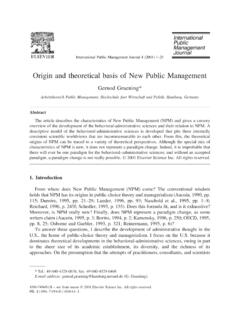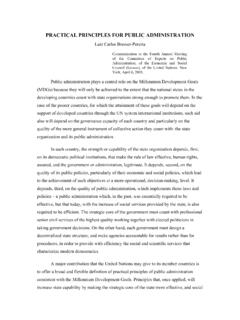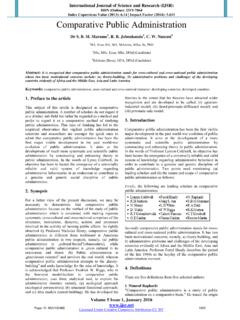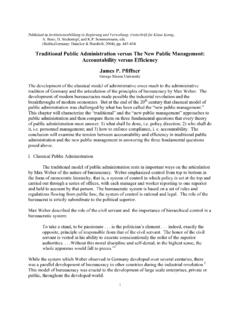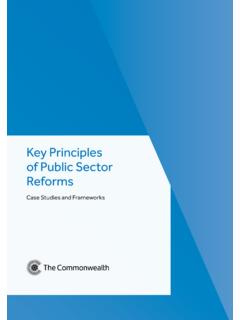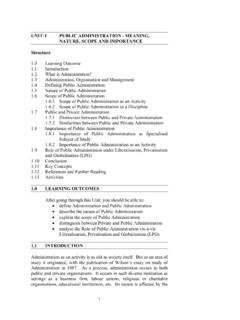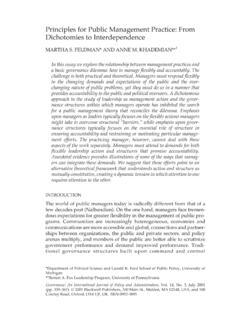Transcription of New Public Management: Emergence and Principles
1 New Public management : Emergence and PrinciplesNazmul Ahsan Kalimullah * Kabir M. Ashraf Alam ** M. M. Ashaduzzaman Nour **AbstractAs a new paradigm of Public administration , New Public management (NPM) points to th e fa ilures and in adeq uacies of Public sector per formance over time and th e problems lying squarely in the nature and processes of Public sector activity and traditional Public administration . It has been developed as a handy shorthand and summary description of the way of reorganizing Public sector bodies to bring their management approaches closer to business methods. Size of the government, centralized bureaucracies, inadequate mechanisms of accountability, waste and inefficiency in resource use etc are all problems which the new Public management sought to address. However, there are few criticisms of the doctrines of NPM from the political perspective and few of the developing countries have become successful in Public sector reform.
2 This paper, based on general review of literature such as relevant books, journals, articles and newspapers, attempts to pinpoint the Emergence , Principles and criticisms of NPM considering its theoretical Public management (NPM) is conceived as 'administrative argument' and 'administrative philosophy' (Hood, 1991) where these two concepts were fraternal rather than identical twins. The concept of administrative argument and administrative philosophy encompasses same concepts of doctrines and organizational design that are Siamese twins (Barzelay, 2001). Administrative arguments are 'nested systems' (Simon, 1983) of ideas concerned with organizational design that can be fragmented with a set of sub-argument. Each administrative argument is generally concerned with a broad range of organizational design issue and each sub-argument is concerned with a single issue of organizational design.
3 Administrative doctrines and justifications are the two components that structured a sub-argument where administrative doctrine is a view of how a single organizational design issue should be1* Professor, Department of Public administration , University of Dhaka Email: Director General, National Institute of Local Government (NILG) and PhD Researcher Department of Public administration , University of Dhaka; Email: National Volunteer, JANIPOP (Jatiya Nirbachon Parjabekkhon Parishad)- National Election Observation Council; Email: JOURNAL, Volume 1, Issue 1, September 2012, ISSN: 2219-4851determined, whereas a justification is a rationale for that view. From this concept, NPM has been seen as an instance of an administrative argument. It is a point of view about organization design in government composed of sub-argument originated from administrative values (Hood, 1991).
4 The administrative values relates three different cluster of values for example, one cluster of values gives priority to efficiency, another prioritizes honesty and fairness and the last one gives priority to robustness and adaptability of systems. Based on the model of administrative arguments Hood and Jackson conclude that NPM as a point of view of organizational design in government that is not utterly lacking in substances and a reasonable person might reject NPM on the grounds of honesty and fairness, for instance, it should give priority over values of efficient task performance (Barzelay, 2001). On the other hand, New Public management (NPM) is an administrative philosophy concerning organizational design in government. An administrative philosophy is a part of a framework that intended to explain the government agenda and authoritative decisions in a given place and time.
5 Hence, the concept of administrative philosophy is a tool of political and historical analysis. The acceptance of NPM is an event which established a climate of opinion in favor of its various doctrines. Both concepts refer to a set of doctrinal arguments despite administrative arguments suggest these arguments share similar types of justifications. Thus, in order to change in organizational design government need to incorporate a satisfying analysis of process of doctrinal change (Kalimullah and Khan, 2011).New Public management is also defined based on two fields of discourse or paradigm for example, Public choice and managerialism. Here Public choice is a contemporary field of discourse about government with wider concern than management , whereas managerialism is a field of discourse initially meant to apply to organizations in the private sector.
6 Despite a common disagreement about the specific illustration of NPM (Dunleavy, 1994) however, the classic formation of NPM has seven directions (Hood, 1991). It focuses on hands-on and entrepreneurial management that is opposite to the traditional bureaucratic focus of Public administration . NPM explicitly sets the standards and measures performances. Another direction is it emphasizes on output control. Alongside, it focuses on the importance of disaggregation and decentralization of Public , services. Moreover, there is a shift to the promotion of competition in the effective delivery of Public services (Kalimullah and Khan, 2011).NPM is a modern management practice with the logic of economics retaining core Public values (Samaratunge, Alam and Teicher, 2008) which are not a static phenomenon but evolving one. The traditional concepts of Public administration have been transformed to cope with the emerging geo-political 2 New Public management : Emergence and Principlesand economic challenges.
7 Indeed, the greater role of the government until the 1960s in socio-economic transformation, market oriented reforms, production, provision and regulatory activities came under severe criticism as there were fiscal crisis, imperious bureaucracy, poor performance and lack of accountability in Public organizations, wide spread corruption, changes in Public expectation and Emergence of better alternative forms of service delivery (Minogue, 1998) that have given rise to the Emergence of NPM (Sarker, 2006). After appearance, NPM becomes a leverage of managing Public sector organizations with two key features for example, one is the separation of policy formulation from operation and secondly, the importance of management inspired by private sector management . This new approach to Public management founded a sharp critique of bureaucracy as the organization principle within Public administration and promised a small but better government, emphasized on decentralization and empowerment, focused on customer satisfaction, promoted better mechanism of Public accountability and institutional development.
8 It is also concerned with the ability of Public administration to secure the economic, efficient and effective provision of Public services, and concern for professional power within Public services and consequent disempowerment of service administration and New Public management : Difference and RelationshipThe paradigm shift from Public administration to new Public management involves a move in the basic design co-ordinates of Public sector organizations that become less distinctive from the private sector and the degree of discretionary power (particularly over staff, contracts and money) enjoyed by Public managers is increased, as the procedural rules emanating from the centre are relaxed. Government reworks budgets to be transparent in accounting terms, with costs attributed to outputs not inputs, and outputs measured by quantitative performance indicators.
9 Public sector organizations should be viewed as a chain of low-trust principal/agent relationships (rather than fiduciary or trustee-beneficiary ones) and a network of contracts linking incentives to performance. Government disaggregates separable functions into quasi-contractual or quasi-market forms, particularly by introducing purchaser/provider distinctions; openes up provider roles to competition between agencies or between Public agencies, firms and not-for-profit bodies; and deconcentrates provider roles to the minimum-feasible sized agency, allowing users more scope for 'exit' from one provider to another, rather than relying on 'voice' options to influence how Public service provision affects them (Dunleavy and Hood, 1994).3 New Public management : Emergence and PrinciplesPublic administration is the organization and management of men and materials to achieve the purpose of the government.
10 It's central idea is the co-operative rational action. It is concerned with the conduct of Public affairs, the management of the Public 's business and the implementation of Public policies. The management of Public programs is known as Public administration . It is the means of translating politics into reality that citizens see every day. According to Gerald E. Caiden (1982), " Public administration refers to the implementation of pronouncements made by recognized Public authorities, the organization of enforcement machinery to ensure Public conformity and relations between the Public and Public officials appointed to further collective interests. It includes the organization of Public affairs, social purposes and collective decision- making, the management of Public institutions, Public offices and Public property, and the administration of the Public by officials, covering attitudes and behavior as well as actions.
